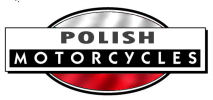




Overview
Manufactured by Gustav Rózychi and K. Zuber, Katowice 1937-1939
128cc motorcycles were produced using two-stroke engines of their own design. When war came, the factory was occupied by the Germans, Rózychi was sent to Dachau, and Zuber escaped and took part in the Battle of Britain.
MOJ History
In 1935, when the Polish industry was recovering from a period of several years of stagnation caused by the global economic crisis, in the Machine Factory and the Iron and Metal Foundry, Eng. Gustaw Rózycki in Katowice, the development of a small-engine motorcycle has begun. The creator of the vehicle marked with the three-letter symbol MOJ (nickname of the factory owner) was Eng. Karol Zuber. In less than two years, design work was completed, and prototypes were made and tested.
The first production machines appeared on the market in the middle of 1937. The design of the motorcycle clearly shows the influence of German technical solutions. This applies in particular to a very solid double frame, closed, made of steel sections with a C-profile. Such a solution of the chassis of a popular motorcycle may raise some objections related to the high price of production. It should be added here that soon, for economic reasons, German manufacturers moved away from pressed metal frames in small-volume vehicles.
A chrome-plated fuel tank (20:1 petrol-oil mixture) with a capacity of 8.5 litres was fitted; this amount was sufficient to complete a 300-kilometre journey without refuelling. Some versions had a saddle tank with slightly larger capacity. The motorcycle had a single-cylinder two-stroke engine coupled with a gearbox, and the piston and cylinder head (equipped with decompressor) were made of light alloys. The molybdenum cast iron cylinder had, in later models, a dual-port exhaust and the crankshaft was fitted with ball bearings. The gearbox was foot-operated, quite rare on motorcycles of this class at that time. It had only two gears, and this was given as an advantage in the manufacturer's advertising catalog.
The engine was protected from below by a millimeter-thick sheet metal strip attached to the frame. The ignition and lighting system was 6V, produced in a magneto-generator of their own design (or possibly Bosch), located underneath the engine flywheel. The parking lights, with the engine off, were powered by a dry battery, located within the headlight assembly on some models. The Rózycki factory also produced carburettors, although those of the German company Graetzin were also used.
The motorcycle was a single seater, but a pillion saddle could be fitted, as permitted by the manufacturer and by the Highway Code.
MOJ motorcycles inspired confidence with a solid and aesthetic appearance, they also had a good reputation as economical and durable. Despite the not very high maximum speed of "about 65 km/h", they participated in many sports and sports-tourist events (including the "Szlakiem Marszalka" rally and the race at Al. Niepodleglosci in Warsaw in 1938) with success. In the spring of 1939 the "MOJ" Motorcycle Club was established in Katowice by the employees of the Machine Factory. The club applied for membership to the Polish Motorcycle Association and in the course of nationwide activities began preparatory work for the rally "For MOJ's prize".
By September 1939, around 4,180 of these motorcycles had been produced, with some design changes being made each year.
| Specifications | ||||
|---|---|---|---|---|
| Engine: | single-cylinder, two-stroke | |||
| Bore x stroke / displacement: | 55x54mm / 123.2cc | |||
| Compression ratio: | 5.5:1 | |||
| Maximum power: | 3.5 hp at 3550 rpm | |||
| Clutch: | wet, multi-disc | |||
| Transmission: | with two gears, foot operated | |||
| Ignition: | magneto | |||
| Generator: | MOJ or Bosch 6V, 18W magneto | |||
| Frame: | double, closed, pressed pressed metal, C-profile sections | |||
| Front suspension: | trapezoidal fork with friction shock absorber | |||
| Rear Suspension: | rigid | |||
| tyres: | Polish tyres "Stomil" 3.00 x 19 | |||
| Wheelbase: | 1225mm | |||
| Empty weight: | approx. 70 kg | |||
| Maximum speed: | approx. 65 km/h | |||
| Fuel consumption: | 2.5L/100km | |||
| permissible load: | 2 people | |||
Sources: Polish History Archive; Zabytkowemotocykleirowery Poland